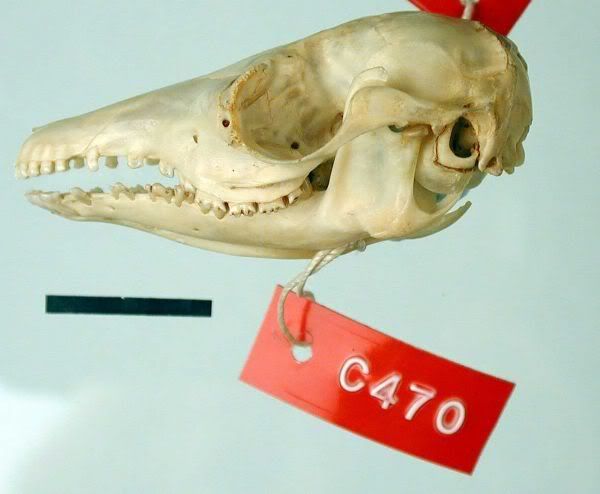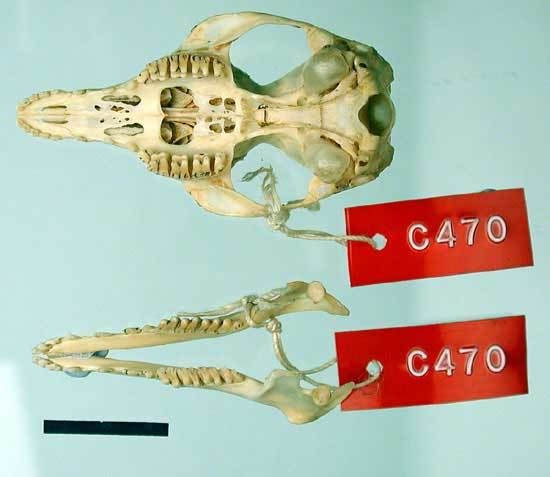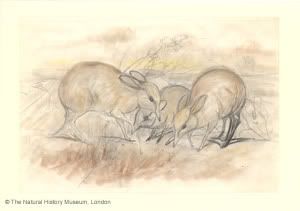|
|
Post by another specialist on Sept 10, 2007 12:38:27 GMT
Head, showing skull and jaw side on, of a Pig-footed Bandicoot Chaeropus ecaudatus  Specimen Reg. No. C 470. Locality: Central Australia Scale line equals 2cms. Photo by Marnie Rawlinson, Cathy Accurso and Ken Walker © Museum Victoria Exterior head, showing skull from above and jaw from below, of a Pig-footed Bandicoot Chaeropus ecaudatus  Specimen Reg. No. C 470. Locality: Central Australia Scale line equals 2cms. Photo by Marnie Rawlinson, Cathy Accurso and Ken Walker © Museum Victoria Interior head, showing skull from underneath and the jaw from above, of a Pig-footed Bandicoot Chaeropus ecaudatus  Specimen Reg. No. C 470. Locality: Central Australia Scale line equals 2cms. Photo by Marnie Rawlinson, Cathy Accurso and Ken Walker © Museum Victoria www.museum.vic.gov.au/ |
|
|
|
Post by Bhagatí on Nov 20, 2007 20:29:51 GMT
|
|
|
|
Post by another specialist on Dec 20, 2007 11:52:13 GMT
|
|
|
|
Post by another specialist on Dec 20, 2007 11:59:55 GMT
 John Gould (1804-1881) Pig-footed Bandicoots (Chaeropus ecaudatus), c.1845. Pencil and chalk, 322 x 475 mm. John Gould’s (1804-1881) name is forever associated with his extraordinary publishing projects. Producing lavish books in the nineteenth century he helped to increase awareness of the amazing diversity of birds and mammals in Australia. Using great skill as an artist and naturalist he was able to draw life-like images of animals based only on their skins. His drawings have provided a record of animals that are now sadly extinct. www.nhm.ac.uk/nature-online/online-ex/art-themes/drawingconclusions/bandicoots_main.htm |
|
|
|
Post by another specialist on Dec 20, 2007 12:01:10 GMT
|
|
|
|
Post by another specialist on Jan 1, 2008 15:54:56 GMT
|
|
|
|
Post by another specialist on Jan 5, 2008 17:50:42 GMT
|
|
|
|
Post by another specialist on Jan 6, 2008 20:41:17 GMT
|
|
|
|
Post by thomasw on Feb 25, 2008 17:32:19 GMT
|
|
|
|
Post by another specialist on Feb 25, 2008 19:00:53 GMT
|
|
|
|
Post by another specialist on Mar 10, 2008 9:44:40 GMT
|
|
|
|
Post by another specialist on Jul 9, 2008 3:35:58 GMT
Chaeropus ecaudatus Author: Ogilby, 1838. Citation: Proc. Zool. Soc. Lond., 1838: 25. Common Name: Pig-footed Bandicoot Type Locality: Australia, New South Wales, banks of Murray River, south of the junction with Murrumbridge River. Distribution: Australia: SW New South Wales, Victoria, S Northern Territory, N South Australia, Western Australia. Status: CITES – Appendix I [Possibly Extinct]; U.S. ESA – Endangered; IUCN – Extinct. Comments: Probably extinct, last taken in 1907; see Ride (1970:200). www.bucknell.edu/msw3/browse.asp?s=y&id=10900008 |
|
|
|
Post by another specialist on Oct 11, 2008 9:53:40 GMT
Taxonomy [top] Kingdom Phylum Class Order Family ANIMALIA CHORDATA MAMMALIA PERAMELEMORPHIA CHAEROPODIDAE Scientific Name: Chaeropus ecaudatus Species Authority Infra-specific Authority: (Ogilby, 1838) Common Name/s: English – Pig-footed Bandicoot French – Bandicoot Pieds De Cochon, Bandicoot À Pied De Porc, Bandicoot À Pieds De Cochon Sans Queue, Péramèle Anoure Spanish – Cangurito Piedecerdo Assessment Information [top] Red List Category & Criteria: Extinct ver 3.1 Year Assessed: 2008 Assessor/s Burbidge, A., Dickman, C. & Johnson, K. Evaluator/s: Lamoreux, J. & Hilton-Taylor, C. (Global Mammal Assessment Team) Justification: Listed as Extinct because it has not been located since the last specimen was collected in 1901. Aboriginal records indicate populations surviving into the 1950s, but there are no indications that it still persists. History: 1996 – Extinct (Baillie and Groombridge 1996) 1994 – Extinct (Groombridge 1994) 1990 – Extinct (IUCN 1990) 1988 – Extinct (IUCN Conservation Monitoring Centre 1988) 1986 – Extinct (IUCN Conservation Monitoring Centre 1986) 1982 – Extinct (Thornback and Jenkins 1982) Geographic Range [top] Range Description: The Pig-footed Bandicoot occurred in Australia. It was recorded from Western Australia, through South Australia and the southern part of the Northern Territory, to south-western New South Wales and western Victoria. The last known specimen was collected in 1901. Reports of sightings in central Australia during the 1920s were unconfirmed. There were recollections of this species by the Pintupi people in the Great Sandy and northern Gibson Deserts into the 1950s (Burbidge et al. 1988). Countries: Regionally extinct: Australia Population [top] Population: It is presumed to be extinct. Habitat and Ecology [top] Habitat and Ecology: It was found in semi-arid and arid areas such as open sclerophyll woodland, mallee, heath, and grassland. Systems: Terrestrial Threats [top] Major Threat(s): The main causes of this species’ demise are unknown, but it declined rapidly following European settlement (Johnson and Burbidge 2008). Destruction of habitat by rabbits and predation by foxes had been thought to be major factors, but these species were not yet present at the time Pig-footed Bandicoot populations crashed. Cats, however, were present and may have been a factor; disease or destruction of habitat by sheep might also have played a role (Johnson and Burbidge 2008). Conservation Actions [top] Conservation Actions: There are no conservation measures pertaining to this species. www.iucnredlist.org/details/4322 |
|
|
|
Post by another specialist on Dec 10, 2008 19:41:32 GMT
|
|
|
|
Post by another specialist on May 1, 2009 9:37:22 GMT
|
|
|
|
Post by RSN on Sept 1, 2011 13:36:39 GMT
|
|
|
|
Post by surroundx on May 14, 2012 12:49:44 GMT
Since C. e. castanotis and C. e. occidentalis are both synonyms of C. e. ecaudatus, there are now no officially recognized subspecies of this taxa. The thread should therefore be renamed by as "Chaeropus ecaudatus" in my opinion.
|
|
|
|
Post by surroundx on Oct 14, 2012 12:58:39 GMT
|
|
|
|
Post by surroundx on May 11, 2014 2:26:33 GMT
|
|
|
|
Post by surroundx on May 11, 2014 2:26:57 GMT
|
|